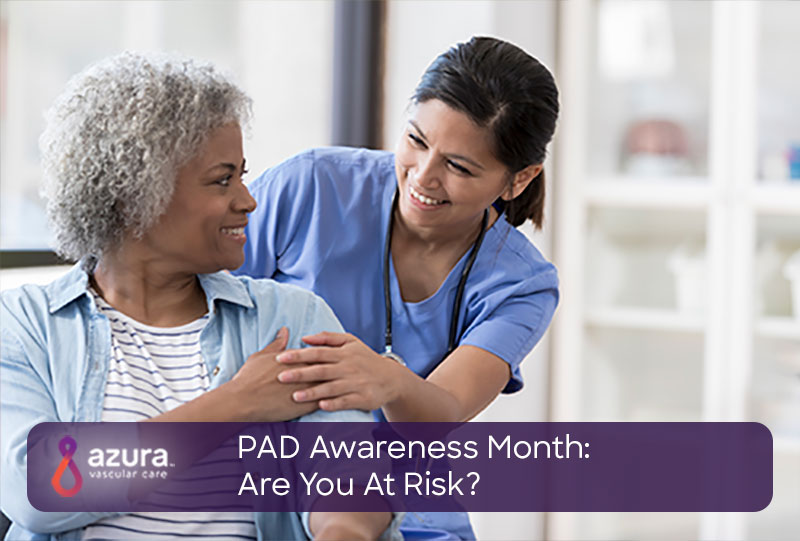
Non-healing toe, foot or lower leg wounds. Leg pain when walking. Leg cramps triggered by activity. These are all common symptoms of peripheral artery disease (PAD). September is PAD awareness month and a great reminder to all to be mindful of this vascular disease and its symptoms as we work to raise awareness of something that affects 8-12 million Americans.(1)
PAD is a slow, progressive, sometimes life-threatening vascular disease that is caused by narrowing or blockages of the arteries in the peripheral arterial system, or the arteries in the limbs. When plaque builds up, blood flow to the limbs is limited and can result in a variety of health problems, which in its most severe form includes limb amputation. Spreading awareness will help educate those who know little about PAD, because this disease is widely underdiagnosed and undertreated.
The goal throughout September is to draw special attention to the symptoms and risk factors of PAD, providing tips on how to prevent and detect the disease. To show just how common PAD can be, here are some facts to be aware of:
- PAD affects 12%-14% of the world’s population.(2)
- One in three diabetics over age 50 suffers from PAD.(3)
- Approximately 150,000 lower-limb amputations in the U.S. can be attributed to PAD each year.(4)
- About 20%-50% of people with PAD are asymptomatic.(5)
- Smoking increases the likelihood of developing PAD by 400%.(6)
How Do I Know If I Have PAD?
Unfortunately, many people are not aware that they have PAD, as it is often asymptomatic or similar to the symptoms of arthritis or simply old age. However, some PAD symptoms you should not ignore are leg fatigue, changes in the appearance of your legs, decreased hair growth on your legs and feet, leg pain, and lower limb sores that will not heal. If you are experiencing any of these symptoms, it is important to see a doctor right away.
Early detection of PAD is crucial, as waiting can lead to more serious complications. If left undiagnosed or untreated, PAD can lead to amputation. Vascular diseases, including PAD, are now responsible for 80 percent of all amputations.(7) It is important to recognize the potential severity of PAD and how ignoring your symptoms can lead to amputation. Pay close attention to your body and make regular visits to your doctor so you can identify any disease including PAD before it progresses.
Are You at Risk?
There are a few risk factors that can contribute to PAD. Smoking is one of the biggest contributors to PAD, as it damages the inner layers of your arteries and causes plaque to build up. The sooner you quit smoking, the sooner you begin to lower your chances of developing PAD. Other risk factors include advanced age, high cholesterol, diabetes, high blood pressure, obesity, lack of exercise, and a family history of vascular disease. If someone in your family has suffered from a vascular disease, your chances of developing PAD are greater. Knowing your family history can be vital so you can watch for the early signs of the disease.
How Can I Prevent PAD?
The best way to prevent PAD or the progression of PAD is to reduce the symptoms. In most cases, this means a lifestyle change. Regular physical activity is often an effective treatment. Your doctor may recommend a program to slowly ease you into a healthier and active lifestyle, including a diet low in saturated fats, which can help lower your cholesterol levels. Quitting smoking will help prevent and slow the progression of PAD and other heart-related issues. In addition, your doctor may prescribe medicine to lower your high blood pressure and prevent blood clots.
Sometimes lifestyle changes are not enough, and patients may need a minimally invasive treatment to restore blood flow to the affected limb. Angioplasty has helped decrease the instances of amputations. Angioplasty improves the blood flow to the limb by inserting a small balloon-tipped catheter into a patient’s artery through the arm or groin. Once it’s in position near the blockage, the balloon is inflated, widening the narrowed artery. Your physician may then insert a wire tube, called a stent, to keep the artery open. Knowing where you stand in the progression of PAD will help you determine what actions need to be taken.
If you’ve been diagnosed with PAD, continue to see your health care provider regularly and ask what treatment is best for you. Many patients are successfully treated with a supervised exercise program or medication; severe cases may require an interventional procedure. The consequences of amputation are often devastating, and many amputations can be prevented through early intervention.
Sources:
- https://www.cdc.gov/heart-disease/about/peripheral-arterial-disease.html
- https://www.blackrock-clinic.ie/wp-content/uploads/2014/03/LBC17_PAD_awareness_day_2014_A4_infosheet_v1.pdf
- http://www.diabetes.org/living-with-diabetes/complications/heart-disease/peripheral-arterial-disease.html
- https://www.chron.com/opinion/outlook/article/Rosales-It-s-time-to-raise-awareness-of-5338441.php
- https://www.ahajournals.org/doi/pdf/10.1161/circulationaha.107.736108
- https://www.nhlbi.nih.gov/health-topics/peripheral-artery-disease
- Carr, Jeffrey (July 2017). How kidney disease, peripheral artery disease, and amputation intersect. Nephrology News & Issues.